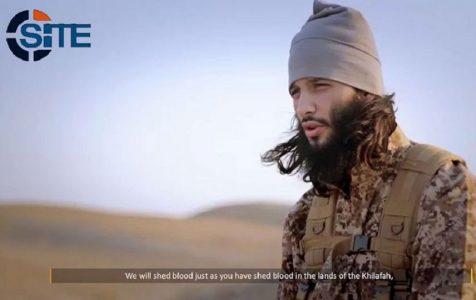
After the huge losses ISIS steps up campaign to inspire new wave of attacks
The man with the Islamic State scarf appears to be playing a kind of jihadist peekaboo.
In the photo, he hides his features behind the terrorist group’s infamous logo but shows just enough background scenery so viewers can recognize his location: New York’s Central Park, in wintertime.
“We are in your home,” reads the photo’s simple caption, posted online a few days after Christmas and circulated widely on a prominent jihadist internet channel.
Precisely when the photo was taken is not known, but the message is chillingly clear. It has been repeated in similar posts in recent weeks, all purporting to show Islamic State operatives casing landmarks in Western cities and urging followers to carry out attacks wherever they are. “It is time to harvest the heads,” the narrator in one such video states.
Such is the typical fare served up by the Islamic State’s propaganda machine, which remains very much alive three months after the fall of the terrorist organization’s capital in Raqqa, Syria. The self-proclaimed caliphate has been reduced to a handful of villages in the Syrian desert, but the “virtual caliphate” fights on, a diminished but still formidable presence focused on rallying the group’s followers in the face of crushing military defeats, according to U.S. officials and independent analysts.
The content has changed significantly since the loss of Raqqa, formerly home to the group’s official media division and production facilities. Gone are the glossy Islamic State magazines and slick videos extolling the virtues of life under militant Islamist rule. In their place is a steady stream of incitements, nearly all of them aimed at offering encouragement and detailed instructions for carrying out terrorist attacks.
Some are amateurish and appear to originate not from studios or official spokesmen, but from bloggers and other volunteers who often are only loosely affiliated with the Islamic State – the online equivalent of lone-wolf terrorists who act without official guidance or instruction. Terrorism analysts say the Islamic State is growing more dependent on such independent platforms, which are capable of distributing highly targeted appeals in scores of local languages and can’t be easily silenced by military strikes.
At the same time, there are signs of new life from the group’s official mouthpiece. Last week, the Islamic State’s Amaq News Agency issued its first English-language communiques since mid-September, just before the fall of Raqqa. The first weeks of 2018 have also seen a sharp rise in traffic on pro-Islamic State social media accounts compared with previous months, according to an analysis released Friday by the SITE Intelligence Group, a private firm that monitors jihadist content.
“The Islamic State is now showing the first signs of a regrouping media operation,” said SITE Executive Director Rita Katz. “The group suffered major setbacks by coalition and regime attacks but is now clearly taking major steps to reassemble its propaganda operation, which is among its most dangerous weapons.”
The newest propaganda campaign illustrates the difficulties faced by counterterrorism officials in seeking to stop militants from connecting with would-be terrorists in the United States and throughout the West. Even after destroying the Islamic State’s sanctuary and successfully blocking – with help from private companies – hundreds of the group’s social media accounts, the terrorists and their supporters continue to find ways to get their messages out, analysts say.
Source: Stripes





